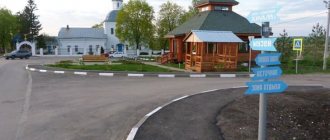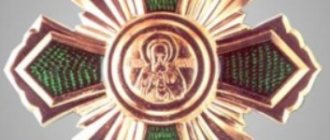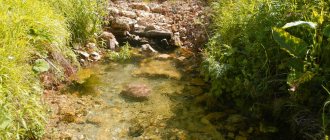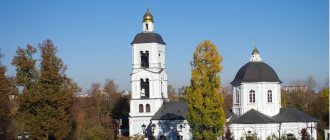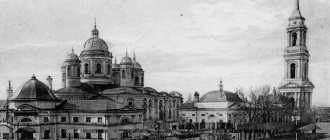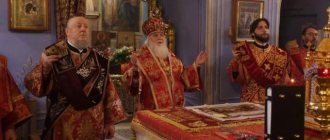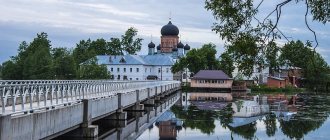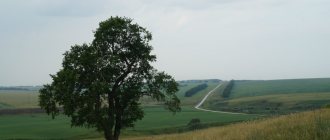Place of miracle
Today many people know about Kolyupanov near the town of Aleksin on the Oka River. They come to a source of healing water, which, according to legend, was dug by the blessed old woman Euphrosyne (c. 1758–1855, commemorated July 16), who spent the last ten years of her life here, on Tula land. There are many legends about the amazing ascetic, but there is also quite reliable information that she came from the princely family of Vyazemsky, belonged to high society, which she left in her young years for the sake of monastic obedience, possibly taking secret tonsure. The Lord gave her the cross of foolishness and endowed her with the gifts of healing people and caring for every creature of God - all her life the old woman was accompanied by animals - cats, dogs, birds; she provided them with her home, oppressing and humbling herself in every possible way. Two great saints and the smartest men of the Fatherland - Metropolitans Platon (Levshin) and Philaret (Drozdov) revered Blessed Euphrosyne and blessed her spiritual works for the glory of God.
The old woman was buried in the church in honor of the Kazan Icon of the Mother of God, built for the residence of the locally revered Kazan image of the Blessed Virgin Mary. Under Soviet rule, the temple was devastated, then burned and, it seemed, disappeared from the face of the earth forever. Only in 1993 did its restoration begin in its original place, which was followed by the creation of the Holy Kazan Convent.
In 1994, the current abbess, Abbess Euphrosyne (Kushnir), came here, almost into the wilderness, into the unknown. Now my mother is already 83 years old, and then the senior engineer of the Tulachermet Production Association, Maria Vasilyevna Kushnir, was full of energy, had wonderful organizational skills, and with God’s help she could do a lot. Mother began to build a temple and equip her small monastery. She was blessed for this work by the then Metropolitan of Tula and Belev Serapion (Fadeev; † 1999), who especially loved monastics. Under him, 11 monasteries were opened in the Tula Metropolis in the blessed 90s of the twentieth century.
And information about blessed Euphrosyne, canonized among the revered saints of Tula, was collected by Schema-Archimandrite Christopher (Nikolsky; †1996), a revered elder. He put a lot of effort into recreating the ancient history of Tula monasteries, many of them arose or began to be revived through his prayers. Mother Euphrosyne followed the spiritual advice of Father Christopher during the construction of the monastery.
– Being blind in the last years of his life, Father Christopher supervised the construction of the monastery as if from the outside. Our mother comes to him and says: “Father, I laid blocks for the foundation.” He answers her: “Dig it up as you put it.” - "Why?" - “Because there is clay there, and we need to make a sand pillow!” But Father Christopher was not here. But I saw everything that was being done.
Then they donated expanded clay blocks. There was no building material then and mother was happy. And the priest: “Give it back.” - "Why?!" - “They are radioactive.” They tried it on - it’s true. Here, Kireevsk, Bogoroditsk, and part of the Tula region were covered by the Chernobyl cloud, and the sand for these blocks was taken from the contaminated area. Nobody really knew this then...
These stories are told by priest Andrei Demin. He has been serving at the monastery for 16 years. He left the capital, built a house near the monastery, and graduated from the seminary. Forever stuck to Kolyupanov, participating in everything that happens here.
In simplicity, in quiet prayers and hard work, the monastery was established - practically from scratch. Outwardly, there was nothing to remind us of the temple that once existed. But a miracle was not slow to appear already at the foundation of the temple. The location was chosen tentatively, and the builders could not fit into the originally chosen size. We decided to change it and ended up on the old foundation. During the pawning, pawn coins from the former church were found.
Everyone who discovered Kolyupanovo back then, in the mid-90s, has a picture in their memory: the walls of the temple were erected, but the huge frame of the dome was still on the ground... And a trickle of people had already reached the monastery and the source. A log platform was set up, and at first they poured themselves directly from a bucket, having asked the mothers for it in advance.
“Miracles happen, we record these cases,” says Father Andrei. – People, without even knowing it, receive healing. Doctors gave a woman with a brain tumor three months to live at most. Out of desperation, she came here and took a dip in the spring. On the way back, she and her husband had an accident. Frightened by a head injury, he took his wife to take a photo - and it turned out that the tumor had disappeared.
And one of the first miracles here was that a boy, blind from birth, regained his sight. Mom came with her last hope, prayed, and anointed them with oil from the lamp. When we returned home to Moscow, we noticed that the child was reaching for the shiny brooch on his mother’s suit. The doctor confirmed the healing. Another baby didn’t speak until he was five or six years old. The mother prayed on her knees before the shrine of Blessed Euphrosyne. And her son comes up to her and suddenly asks: “Mom, why are you crying?”
Blessed Euphrosyne hears everyone, just pray. It is no coincidence that during their lifetime the saints say: when we leave, address us as if we were alive. Our prayers will be near God!
The holy relics of the blessed Elder Euphrosyne are located in the newly built Kazan Church. They remain hidden. The material for the shrine was donated by the Moscow Metro. When the metro builders arrived in Kolyupanovo to install the reliquary, they began to dismantle the blocks, one of them said: “Perhaps there are no relics here. How do you know?" And as soon as he said this, an image of the saint appeared on the white tombstone: how she was buried, in a coffin. It's like a photograph. The image finally disappeared only after three months; many became witnesses, Mother Abbess showed it to everyone. And the workers, when this happened, fell to their knees and asked forgiveness from Blessed Euphrosyne...
The Holy Kazan Convent continues to be developed. The Trinity Cathedral was erected next to the Kazan Church. For a long time, only two labored in the monastery - Abbess Euphrosyne and nun Lavrentia. Mother Lavrentia is now over 90. She walks with a cane, but, to the amazement of the doctors, she can still fly. Now there are already five sisters, there is one novice. Here they unquestionably hope for God’s help and the intercession of the holy ascetic.
Kolyupanovo is an amazing place. Whoever came here once certainly returned or kept in his heart the memories of his stay here as the brightest moments of his life. And the monastic notebooks with stories about the heavenly help of Blessed Euphrosyne multiply, replenished with entries.
Photo by the author, from the monastery archive and free sources on the Internet
Source of the Blessed Elder Euphrosyne
Source of St. Efrosinya in Kolyupanovo is located in the Aleksinsky district of the Tula region next to the Kazan Monastery. The waters of the source feed the ancient Russian river Oka. But in addition to one of the main water arteries of the Tula region, the spring fills the bodies and souls of believers with its water. It is an integral part of the culture and religion of the Land of the Masters. Pilgrims from neighboring regions come here every day, because the source of Euphrosyne, without any doubt, has miraculous properties. This water helps against poor vision and cancer. Even if the pilgrims who come here are not sick, the key will strengthen their health and fill them with grace.
When visiting the source of Euphrosyne, everyone should know the life of the locally revered saint. Evdokia Vyazemskaya, a representative of the famous princely family, graduated from the Educational Society of Noble Maidens at the age of 18 and immediately went to Empress Catherine the Great as a maid of honor. She was familiar with Suvorov, Naryshkin and many other Russian secular giants of the second half of the 18th century.
Did Catherine II's maid of honor really dig up Euphrosyne's spring in Kolyupanovo herself? But Evdokia and Euphrosyne are different names. The fact is that the young lady-in-waiting suddenly felt a burning desire to devote herself to God. Having escaped from the palace, she wandered around temples and monasteries, doing any kind of work. In Moscow, Metropolitan Platon blessed her for the feat of foolishness, calling her Euphrosyne.
In 1845, the old woman, having already become famous by that time for her piety and miraculous deeds, moved to the village of Kolyupanovo, Tula province. Not far from the Kazan Church in this village, she finds a secluded place for prayer in a ravine, and digs a well there. She urged everyone who came to her with requests and for blessings to drink from her well in order to be healthy.
Almost 200 years have passed since then, and the flow of petitioners and sick people going to the holy old woman has not weakened. Those who come to Kolyupanovo come to pray at the Kazan Church, sympathize with the old woman’s shrine, ask her for a solution to their problems and illnesses, and then visit the Holy Spring of St. Euphrosyne.
There is no exact address for the key and the Kazan Monastery, since Kolyupanovo is a small settlement. However, moving from Aleksin along Lomonosov Street or turning on the P-132 highway towards Pershino, you will reach a fork with a sign to the Holy Spring. It is also possible to get there by rail. In this case, you will need to get off at Kolyupanovo station, located on the Tula-Aleksin line.
Team Nomads
The healing spring of St. Euphrosyne is located on the territory of the Holy Kazan Convent in the village of Klyupanovo and is one of the most revered holy places in the Tula region. Blessed Elder Euphrosyne was the maid of honor of Catherine II, after which she labored as a holy fool in the Serpukhov Vvedensky Vladychny Monastery. She was sent to the Klyupanovskaya monastery in old age, where she spent the last 10 years of her life. She was buried here.
In 1988, the old woman was canonized as a saint in the Tula region.
The source of Saint Euphrosyne was created by her forces. In her desire to help everyone suffering from diseases of body and spirit, the old woman herself dug up a spring and said that it would bring salvation to everyone. As a parting word to the believers, the old woman placed an order at the spring for those who come to take water in order to be healthy. Today this inscription can be seen directly above the source on a metal plaque. During the years of the old woman’s life, many came to her for help, and she sent everyone to her well. They began to call it “Mother’s Well.”
In 1885, a chapel was built over the source, which in 1909 was equipped with a more modern and reliable design, and was also equipped with a well. Bathing in healing water can be done in the baths. There are two of them near the source: for men and women. On the veranda in front of the baths there is a text of a prayer for help in healing. The water from the spring is believed to have special powers. It can even help cure cancer. Cases of instant healing at the source of congenital blindness, muteness and deafness in children and adults have been recorded. How to get there, where it is: Address: Russia, Tula region, Aleksinsky district, Klyupanovo village. Directions: The distance from Tula to the village of Klyupanovo is 75 kilometers. If you go by car, the road to the village leads along the Simferopol highway. At kilometer 114 there will be a turn to Aleksin, and after that there will be a sign to Klyupanovo. There is a small parking lot next to the source. The road has an asphalt surface. From Tula to the Klyupanovo station there is a train "Uzlovaya-Aleksin", but from the station to the spring you need to walk through the forest for about 2 kilometers along a path on which there will be signs.
THE HEALING STORE OF EUPHROSYNE Orthodox believers travel to the village of Kolyupanovo in the Tula region to plunge into the source of the blessed old woman Euphrosyne. According to legend, water from the spring relieves all ailments, can restore vision and heal tumors, and prayer near the cross at the entrance to the bathhouse can give children to infertile couples. The Holy Kazan Convent and the source of Euphrosyne Kolyupanovskaya are located near the village of Kolyupanovo in the Tula region. The distance from Moscow to the monastery is about 180 km. To get from the capital to the monastery by public transport, you need to get to Tula from the Kursky station, and then transfer to the train going along the route Uzlovaya - Aleksin. Get off at Kolyupanovo station and walk about 2 km following the signs to the monastery. The Runaway Maid of Honor In the world, Elder Euphrosyne was called Princess Evdokia Vyazemskaya. In 1776, the girl graduated from the Institute of Noble Maidens at the Smolny Monastery in St. Petersburg and became a maid of honor at the court of Empress Catherine II. The young princess quickly became bored with social life, and she decided to leave the court to devote herself to God. But Evdokia was afraid that the empress would not want to let her beloved maid of honor go, and decided to flee from the palace, faking her own death. Evdokia left her clothes on the shore of a pond in Tsarskoe Selo so that the courtiers would think that the girl had gone swimming and drowned, and she changed into a peasant dress and left the courtyard. However, the empress did not believe in the death of her favorite and ordered a search to be organized. The runaway girl was returned to the court, but was soon released. Catherine realized that the girl’s intentions were serious, and did not dare to interfere with her. Thus began Evdokia’s wanderings through monasteries and temples, which lasted for more than 10 years. In 1806, Evdokia reached Moscow, where she met with Metropolitan Platon, who listened to her story and blessed the runaway maid of honor for the feat of foolishness. Under the fictitious name “fool Efrosinya,” the princess went to the Serpukhov Vladichny Vvedensky Convent, where she began to live as a novice. By that time, the young lady had completely given up her secular polish: Euphrosyne wore a shirt made of coarse fabric, in winter she dressed up in a man’s sheepskin coat, and occasionally covered her short-cropped hair with a rag or a light cap. The blessed one did not wear shoes - even in the snow Euphrosyne walked barefoot. Under her shirt she always wore chains - a heavy metal chain and a copper cross around her neck. In her cell, the holy fool kept two cats, three dogs, chickens and turkeys. She slept on the floor along with dogs and other animals. Efrosinya lit the stove only in the summer, and in the winter there was terrible cold in her home. They say that there was a constant stench from the animals in the cell, and the novice herself said that the smell replaced her perfume, which she “used so much at court.” The inhabitants of the surrounding villages and the nuns revered the blessed one - they say she could foresee the future and knew how to prepare healing herbal decoctions to heal the suffering. Take water from my well... Efrosinya moved to the village of Kolyupanovo at the invitation of her admirer, landowner Natalya Andreevna Protopopova. There the blessed one lived the last ten years of her life. For solitary prayers, Elder Euphrosyne chose a ravine on the banks of the Oka River. There she dug a well and said to the sick who came to her: “Take water from my well and you will be healthy!” Today, this inscription on a wooden tablet adorns the entrance to the bathhouse located at the Efrosinya Kolyupanovskaya spring. The news about the blessed one and her holy spring quickly spread throughout the surrounding area of the village. Elder Efrosinya healed not only the landowner Protopopova, who suffered from hemoptysis and leg diseases, but also other residents of Kolyupanov. There is a known case when Protopopova’s nephew became seriously ill on the eve of his wedding, and the blessed old woman prepared a bath of medicinal herbs for him, after which the completely healthy groom went to the altar. Euphrosyne also helped women in labor - after her prayers, even the most difficult births ended successfully.
Three days before her death, the blessed old woman had a vision - two angels appeared to her and invited her to come with them. So Euphrosyne realized that her earthly journey would soon end. In memory of herself, she distributed various objects to believers - icons, crosses, and then on July 16, 1855 she died after receiving communion. The body of the old woman was buried in the Kazan Church in Kolyupanov. Believers flocked there to venerate the blessed one’s grave, pray for healing and draw water from the spring. News of the miracles that took place in Kolyupanov spread throughout the country. Soon a canopy was installed over the source and a bathhouse was built, and the church ministers started a special book to record evidence of miraculous healings. By 1911 there were 55 such stories. New Monastery In 1933, the church where Euphrosyne was buried burned down, and the source fell into disrepair. But in 1988, the canonization of Blessed Euphrosyne took place, and in 1993 the construction of a stone church began, and two years later the Holy Kazan Convent was established in Kolyupanov. The holy spring of Euphrosyne Kolyupanovskaya was also restored. Now there are two baths - men's and women's, where believers can take a dip and get water. From the monastery to the source there is a rather long descent. There is a cross in the middle of the road, to which people who want to create a strong family and have children go to worship. Those who want to repent of the grave sin of infanticide also come here—mostly women who have had an abortion.
Prayer before immersion in the Holy Spring: Lord! Heal my mental and physical ailments with Your life-giving source. Cleanse me, a sinner (servant of God..., servant of God...) from all ailments. In the name of the Father and the Son and the Holy Spirit. Amen. Prayer after bathing. God! Thank you for Your Life-Giving Source, for the fact that You have cleansed my soul and the body of the sinful servant of God (name), (sinful servant of God (name)) from all ailments. In the name of the Father and the Son and the Holy Spirit! Amen. RULES OF CONDUCT Brothers and sisters! A holy spring is a place of special reverent behavior. It is prohibited: 1. Drinking alcoholic beverages. 2. Smoking. 3. Leave garbage, throw money and any objects into the font. 4. Walk and bathe animals. 5. Talk loudly and play music. 6. Light fires near a source. 7. Use the Holy water of the source for household purposes (washing floors, cars, washing, etc.).
______________________________________________________________________________________________ SOURCE OF INFORMATION AND PHOTO: Team Nomadic Sights of the Tula Region. Museums of Russia: Guide / A. V. Lavrentyev, I. B. Purishev, A. A. Turilov; compiled by Yu. M. Kirillova.. - M.: Profizdat, 1984. - 352 p. - (One hundred paths - one hundred roads). — 100,000 copies. (in translation) https://www.aif.ru/society/history/kladez_staricy_efrosini_kakie_bolezni_iscelyaet_kolyupanovskiy_istochnik Holy places of the Tula region.
| The attachment | Size |
| 114.9 KB | |
| 186.1 KB | |
| 114.38 KB | |
| 88.93 KB |
Kolyupanovo - the abode of the holy fool princess
In this village, the locally revered saint, according to legend, a lady-in-waiting of Catherine the Great, known as Euphrosyne, who escaped from the imperial palace, ended her days. By special order of the bishop, the blessed one was buried in the church under a bushel. But in the 1990s, no one remembered where the temple was in Kolyupanov. A bare field and a few graves are all that remains. Almost no one believed then that not just a temple, but a monastic monastery could grow in this empty place.
* * *
The year is 2006. The small temple is illuminated from time to time by flashes of lightning, and rain drums on its roof. It's completely dark outside, it's late. Only candles and lamps are lit inside - just enough to make out the words of the evening rule. There is such a rumbling noise all around that it seems like the windows will fly out. Storm.
We, two students who arrived in the Tula region, in the village of Kolyupanovo, the day before, were diligently polishing candlesticks. Obedience is more important than the evening rule: there’s nothing, there’s nothing to habitually stand at attention when saying prayers! Listen and do your thing. And then all the workers and nuns of the monastery, one after another, approach the elderly nun. Abbess Euphrosyne (Kushnir) gives the last orders for this long day and blesses for the night. The seemingly unenviable “apartments” - a dilapidated trailer that only fits two beds - seem like an earthly paradise. There is nothing to do except bury your head in the pillow and fall into a light sleep after a busy monastic day. We stayed in the monastery for only a day and went home, not even imagining that we would ever be able to visit here again, at the Holy Kazan Convent. Year 2014. Moscow, Simferopol highway, M-2, Tula, Aleksin... - we are coming back! * * *
Source of Blessed Euphrosyne
Kolyupanovo is two hours by car from Moscow or eight hours by train: trains, trams, buses, and then on foot through the fields along a rural road, along the edge of a silence that is uncanny for a Muscovite. Nobody expected that a women’s monastery would appear here at the end of the 20th century. This was unimaginable even in 1990-1991: where is the monastery - in an open field? However, one person knew for sure about the future monastery back in the 19th century: a locally revered saint, blessed one named Euphrosyne. She appeared in Kolyupanov as an almost ninety-year-old old woman. In shabby clothes, with a cropped head, often barefoot, the old nun aroused ridicule from teenagers and rude peasants. And she herself, it seems, did everything so that they would laugh at her and not a single soul would know about her inner life: about the prayers in which she spent her nights, about the chains with which she humbled her flesh. And more than half a century ago, this woman led a completely different way of life, which few knew about: an allegedly illiterate nun who lived in the same room with cats and dogs, in the summer she lit a stove in her small hut, in the winter she let frost into all the cracks, and derogatorily called herself “Fool Euphrosyne”, was brilliantly educated, knew several foreign languages and all the subtleties of social etiquette... * * *
Tombstone
of Euphrosyne.
By chance or not, representatives of princely families, who were later glorified by the Church as saints, received this name in monastic vows. This is the famous princess Fevronia of Murom, who ended her earthly life in a women's monastery; at the age of 12, Princess Predislava, known as Euphrosyne of Polotsk, entered a monastery; Milica, Serbian princess, wife of the famous Prince Lazar, who died in the fateful battle for Serbia on Kosovo; wife of Prince Dimitry Donskoy Evdokia. Euphrosyne Kolyupanovskaya also had a noble origin - she is credited with being related to the princely house of Vyazemsky. Once, already in old age, she indirectly made it clear that she belonged to the first graduating class of the Smolny Institute of Noble Maidens in St. Petersburg. And she was the maid of honor of Empress Catherine II. And one day, together with two other inhabitants of the palace, she escaped, faking her drowning: on the shore of the pond they left luxurious dresses, changed into simple clothes, and went wandering. Two remained unknown ascetics - it is only known in which monasteries Martha and Solomiya ended their lives. Euphrosyne lived and worked at the Vvedensky Vladychny Convent in Serpukhov for about 40 years. And she took upon herself the feat of foolishness not arbitrarily, but with the blessing of Metropolitan of Moscow and Kolomna Platon (Levshin). It was possible to restore this and other information about her life largely thanks to the rector of the Kazan church in the village of Kolyupanova, priest Pavel Prosperov. By the way, he was one of those whom the blessed one guided on the monastic path - Father Paul received tonsure at the Trinity-Sergius Lavra. Thus, she guided some to monasticism, and sobered others from the frenzy of passions. Extremely strict with herself, Blessed Euphrosyne treated people who were visited by grief with special care and love. But the most “spectacular” remains in people’s memory—miracles. The common people reached out to the saint for healing. And he retold to each other cases when the holy fool spoke about something that she should not have known about. For example, she warned about the Crimean War (1853-1856), about the attack on Russia by Turkey, France and England many years before; spoke about the French emperor long before the revolution of 1848, which put an end to the French monarchy and brought to power Napoleon III, who a few years later proclaimed himself emperor. * * *
Blessed Euphrosyne on her deathbed
Blessed Euphrosyne spent the last years of her life in the village of Kolyupanov, where she died peacefully, a hundred-year-old woman. The Tula bishop allowed her to be buried under cover in the church in the name of the Kazan Icon of the Mother of God. Six priests performed the funeral service for the old woman, and the crowd who came to say goodbye to her many times exceeded the capacity of the temple to accommodate people. Many hoped that, finally, even after the death of the ascetic, the secret of her life and origin would be revealed by Metropolitan of Moscow Philaret (Drozdov), who knew Euphrosyne from the Serpukhov Monastery: it was to him that she especially addressed those who approached her with questions. They sent him to find out: what should be written on the gravestone? The saint ordered to write simply:
“Euphrosyne the Unknown. God has chosen the turmoil of the world, let him put to shame the wise.”* * * *
...When the future abbess of the convent, Abbess Euphrosinia (Kushnir), arrived in Kolyupanovo in 1993, there was a wasteland here, there was devastation all around. Three or four families lived nearby, that's all. A bare field and a huge pit where the neighbors carried all the garbage... Nothing remained of the old rural church except documentary evidence of its existence, and even the old-timers could not indicate exactly where it stood. During the years of Soviet power, the Kazan Church was closed, turned into a shoe workshop, and in 1931, due to the negligence of the workers, it caught fire and burned to the ground. The future abbess was blessed by her confessor, Schema-Archimandrite Christopher (Nikolsky), for the construction of a new church in Kolyupanov. Father greatly revered Blessed Euphrosyne Kolyupanovskaya, and the Holy Kazan Monastery became his favorite brainchild. First of all, the future Mother Superior Euphrosinia went to the collective farm and asked the director for a tractor. During the work, they suddenly discovered the foundation, the masonry of the old temple! As a result, a new one was built in the same place, and very quickly - in about a year. In this temple, Kazan, to this day the relics of Blessed Euphrosyne Kolyupanovskaya are located - they remained exactly in the place where they were placed a century and a half ago. And already in 1995, something that few people believed in finally happened: a convent for women appeared in Kolyupanov. * * *
In general, each monastery has its own unique atmosphere and its own small characteristics. Here, in the Holy Kazan Monastery, people live side by side with animals, and in some way this is reminiscent of how the blessed patroness of the monastery spent her life. “I’m worse than dogs,” the former princess said to her visitors, and went to sleep on the floor along with her four-legged pets, of which she had many. ...In the monastery kitchen, three pot-bellied puppies roll out to meet us. Give them games, and local cats serve as excellent companions in this activity - there are many of them here. One ball of cats and puppies rolls on the floor for the amusement of people, and the serious, usually preoccupied face of novice Galina - an old-timer of the monastery who has lived in Kolyupanov almost from the very beginning of its construction - becomes soft and smiling. The puppies were thrown into the monastery: Galina found a “live”, moving bag at the gate, opened it and saw four furry faces. One was given away, three were left behind. Mother Superior takes the blind cat in her arms: strokes it, takes pity on it, protects it from the impudent cat-suitor. And the animals always follow Galina, joyfully and with great readiness accompany her anywhere. Even the dog, who lived outside the gates for a whole year and did not dare to enter the monastery fence, is now in this “escort”. This is how people and animals live. * * *
How many years have passed since our first visit, the monastery is almost unrecognizable. Where are the potatoes that we weeded near the monastery wall? Where is the trailer, dilapidated, but still cozy? Now everything is different here, and among the abundance of new buildings the eye picks out only one familiar size - a small temple that once shook from the thunderstorm that rumbled around: rustically cozy, with simple icons on the walls.
The second temple in the name of the Life-Giving Trinity flaunts, a bell tower, a guest house, a bishop's house, a refectory, and a prosphora appeared. The previously almost deserted area around the monastery has become overgrown with houses. In the apt expression of the artist George, whom we will later meet in the monastery, “people are running.” Are they fleeing the city? From the city. Previously, says Georgy, about 20 people lived on this side of the river, now there are 120! It seems that only Abbess Euphrosinia has not changed: she is still as tireless and strict. Today, six people live in the monastery, including the abbess. Then she was the only one in the tonsure, today there are several more nuns. The nuns are middle-aged women. Young people work a lot, and the new generation is not very accustomed to work. And there are no special amenities: there are problems with water, the heating is stove. Life is very simple, rustic. Not everyone can do it. And a lot of people come. But not everyone actually goes into the monastery itself. They descend further, along the road down to the source, which Blessed Euphrosyne Kolyupanovskaya herself dug in a ravine a century and a half ago with her own hands. Unfortunately, people often come only to the source, for health, without even bothering to go to the temple. Although it happens the other way around: others think about life here, turn to God, and receive baptism. Adults are baptized directly at the source. Today, however, there are few people willing. And the source is amazing! The road to it descends steeply into a ravine until it comes to a bathing area buried in forest foliage.
* * * …“Have you never taken a dip in the springs?! How I envy you!” - said the man we met at the font when we went down there for the very first time, eight years ago. I don’t remember his face or name, I only remember that he was terribly happy and somehow... peaceful. Everything is very peaceful here: the most amazing thing after Moscow is the silence, and this peacefulness, the slowness of movements and thoughts, clarity. We sat and the pilgrim talked about the source, about the extraordinary grace that we will feel after taking a dip. When he said goodbye and left, we all sat on the bench, dangling our legs, were silent, and even with all our neophyte ardor did not dare to go inside. There are days in the summer when rain starts “out of nowhere,” out of nowhere. So it was then: suddenly large drops began to drum frequently, in the most merciless manner, on the bench, on our shoulders and heads. It was as if someone was forcing, hurrying: sit full, sit full, take a dip! And to this day I remember this ice water! But when we got out, suddenly something happened to us: a feeling of happiness, as if in childhood, overwhelmed us, poured over the edge - you smile, can barely restrain yourself from laughing with joy... but no, why are you holding back - you’re not on the subway! And when we left the bathhouse, the bright sun blinded our eyes: there was not a cloud in the sky, which had burst into rain ten minutes ago.
* * * How to write about a monastery in which you did not live? What and how to convey to a person who has never been here? Some will come for holy water, with living faith, some with half-hearted faith, some with a mustard seed. For some, climbing the long stairs to the monastery will truly be an ascent to some new, completely different life; for others, all this will remain an interesting attraction of the Russian outback. A miracle is different for everyone, and always timely. As for me, the unexpected, incomprehensible return here, into the supernatural silence and clarity of Kolyupanov, is a small miracle.
Photo by Vladimir Eshtokin
Author: POSASHKO Valeria https://www.foma.ru/kolyupanovo-obitel-yurodivoj-knyazhnyi.html
Holy Kazan Convent
In Kolyupanovo, the Holy Kazan Convent is surrounded by birch groves and silence, broken only by the sound of the wind in the leaves or the singing of birds. To find Kolyupanovo, just write “St. Kazan Convent, Tula Region” instead of the address in the navigator. Plan your route and be sure to come here!
The Holy Kazan Convent and the village of Kolyupanovo itself are located very close to the ancient town of Aleksin. You can get here not only by car, but also as part of an organized pilgrim group or on your own by train from Tula. It is possible to use the bus. To do this, you should leave the Aleksinskaya bus station along routes 107, 128, 117, 123 or 126 and get off at the “Turn to Avangard” stop. Ticket prices for public municipal transport are low.
In Kolyupanovo, the Holy Kazan Convent is not the only attraction and shrine. The Miraculous Spring of St. Euphrosyne is also located here. You can often meet people who simply come with bottles just to fill up with water and leave. Pious citizens are recommended, when visiting the source, to go to the Holy Kazan Convent for the liturgy or to venerate the shrine with the relics of Euphrosyne. Just don't forget to turn off your phone. Photography and noise are prohibited on the territory of the monastery.
In general, this place combines two completely different miraculous stories. One is connected with the appearance of a temple on this site, and the second with the life of the holy elder Euphrosyne. And in 1995, by Decree of the Patriarch of Moscow and All Rus' Alexy II, the young Holy Kazan Convent appeared here.
Legends say that a temple in honor of the icon of the Kazan Mother of God existed here even before the founding of the village of Kolyupanovo in the 16th century. It was made of wood and had become significantly dilapidated by 1695. Then it was rebuilt. During the reign of Catherine II, the wooden church burned down, and they were not allowed to build a new one. It was difficult for the residents of Kolyupanovo to go to services in the neighboring village. It was there, in Fomishchevo, that the temple icon of the Kazan Mother of God, which survived the fire, was located. The diocese was deaf to the petitions of the parishioners of the burnt church. But this continued until the icon of the Kazan Mother of God disappeared from the temple in Fomishchevo. She was found on a birch tree near the ashes in Kolyupanovo. This phenomenon was repeated more than once, and this interested local landowners, who insisted on blessing the construction of a new church. In 1783, the Church of the Kazan Icon of the Mother of God was erected with the money of the Bobrishchev-Pushkins.
62 years after this, the holy fool Euphrosyne comes to live in Kolyupanovo. Here she spends the last 10 years of her life. During this time, she managed to perform many miracles in the name of Christ and dig a miraculous well, to which today pilgrims come from all over Russia.
In the village of Kolyupanovo, the Holy Kazan Convent simply could not help but arise. And even after hundreds of years, sisters, a monastery, and two churches still appeared here: Trinity and Kazan.
Kolyupanovsky healing spring in the Tula region
The Holy Spring of Blessed Euphrosyne is located next to the Holy Kazan Convent in the village of Kolyupanovo, Tula Region. There is also the grave of the blessed old woman, née Princess Vyazemskaya. Wanting to devote her life to God, Euphrosyne left the court and, with the blessing of Metropolitan Plato, took upon herself the cross of foolishness for Christ's sake. In 1845, the blessed one settled in the village of Kolyupanovo, where she spent the last years of her life. Her favorite place of prayer was a ravine on the outskirts of the village, through which a stream flowed. She dug a well near the stream, from which she advised the sick who turned to her for help to take water, and then they would certainly be healthy.
www.pravoslavie.ru
The temple in which the relics of the blessed old woman rested existed until 1929, until it was burned without a trace during the time of persecution of the faith. All that remained was a clearing in the middle of the forest, where, through the efforts of people, the grave of Euphrosyne and the miraculous spring were protected. The suffering continued to come to him for help. In 1996, the Kazan Church was completely rebuilt and Orthodox services began to be held in the monastery again.
Visiting these places, many pilgrims note that this is an amazing place. It’s as if a special atmosphere of asceticism and indescribable bliss reigns. Here the soul is truly cleansed. It’s no wonder that the flow of pilgrims is only growing year after year. People come to pray, venerate the relics of the blessed old woman and receive healing from her source.
Water from the source of Euphrosyne relieves many diseases. The well itself is decorated with marble, on which the image of Saint Euphrosyne is laid out in mosaics. Once upon a time, the water from the source barely ran, and people could not bathe in it, they only doused themselves, but this was enough to gain health. Now the source has gained strength, the pressure in it is very high, water flows out of three pipes and goes into the baths. Men's and women's baths were built, in which it is necessary to plunge headlong at least three times. It is believed that after this the disease goes away without a trace.
Miracles of Healing
In the church book at the temple, records are kept of miracles of healing after bathing in the holy spring. Mother Superior describes one unforgettable incident that occurred in 1995 with a three-year-old boy Dima, blind from birth. His parents lost all hope of recovery and in despair turned to God for help. They brought the child to the newly built monastery, held a service, ordered a prayer service for health, venerated the relics of Euphrosyne, took a blessing from the abbess and took the child to the source. They washed the child’s face three times with healing water, and then dipped his head in. The boy immediately opened his eyes and began to see.
A similar incident occurred with six-month-old Sorvin Sashenka, who was also blind from birth. Doctors claimed that he had no chance of regaining his sight
old.aleksin.tula.ru
no even after the operation. The parents brought the baby to the monastery. After praying and washing from the spring, the child regained his sight and his eyes began to react to light. Doctors, having examined the child, did not find an explanation for this amazing fact. There are many such stories of healing of blind children recorded here. Mother loves little children and does not refuse them her help. Doesn't offend adults either.
People go to the source in families. One couple was very afraid to take a dip, as they had a bad cold, but after swimming in the spring, all their illness disappeared. There are many cases of healing of diseases of the respiratory system with miraculous water, such as sore throat, laryngitis, colds, runny nose, pharyngitis, diseases of the bronchi and lungs, asthma, bronchitis, cough, pneumonia, tuberculosis. You can't count them all. Taking a dip in water is useful even in severe frost - no cold will bother you.
The woman said that for many years she was terribly tormented by her kidneys. After she began to constantly come to the source for water to drink at home, the disease does not bother her. One day a pilgrim arrived with a severely swollen leg. Several times she was taken to the bathhouse and immersed in water with her head. The woman left the monastery practically healthy.
Holy water from Mother's spring is often the last hope for seriously ill people, especially for cancer patients. She does not refuse those who ask Euphrosyne for health. “Everyone who drinks water from my well will be healthy,” this is the covenant of Euphrosyne and the blessing of the water in the source to help people. Through the prayers of the saint and according to his faith, everyone receives healing of soul and body.
Address: Russia, Tula region, village Kolyupanovo

